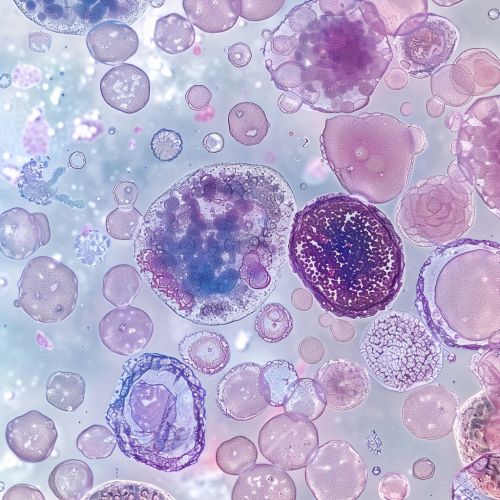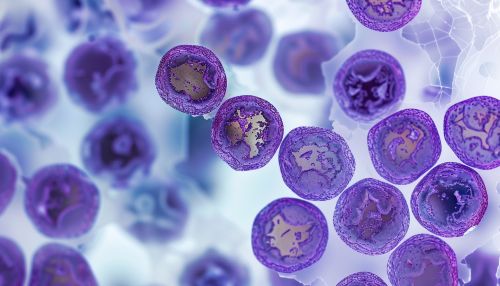Exosomes
Introduction
Exosomes are small extracellular vesicles (EVs) with a diameter ranging from 30 to 150 nanometers. They are secreted by various cell types into the extracellular environment and play a crucial role in intercellular communication. Exosomes are formed within the endosomal network and are released when multivesicular bodies (MVBs) fuse with the plasma membrane. These vesicles carry a diverse array of biomolecules, including proteins, lipids, and nucleic acids, which can influence the physiological and pathological states of recipient cells.
Biogenesis
The biogenesis of exosomes begins with the formation of early endosomes, which mature into late endosomes or MVBs. Within MVBs, intraluminal vesicles (ILVs) are formed through the inward budding of the endosomal membrane. The endosomal sorting complexes required for transport (ESCRT) machinery, along with associated proteins such as ALIX and TSG101, play a pivotal role in the formation of ILVs. Once MVBs are fully formed, they can either fuse with lysosomes for degradation or with the plasma membrane to release exosomes into the extracellular space.
Molecular Composition
Exosomes are enriched with a variety of biomolecules, which reflect the cell of origin. The molecular composition of exosomes includes:
- **Proteins**: Exosomes contain membrane proteins, cytosolic proteins, and proteins involved in vesicle trafficking such as tetraspanins (CD9, CD63, CD81), heat shock proteins (HSP70, HSP90), and Rab GTPases.
- **Lipids**: The lipid composition of exosomes is distinct and includes cholesterol, sphingomyelin, and ceramide, which are crucial for membrane stability and vesicle formation.
- **Nucleic Acids**: Exosomes carry various nucleic acids, including messenger RNA (mRNA), microRNA (miRNA), and other non-coding RNAs. These nucleic acids can be transferred to recipient cells, influencing gene expression and cellular function.
Functions
Exosomes serve multiple functions in physiological and pathological processes:
- **Intercellular Communication**: Exosomes facilitate communication between cells by transferring bioactive molecules, thereby modulating the behavior of recipient cells.
- **Immune Modulation**: Exosomes can modulate immune responses by presenting antigens to immune cells or by delivering immunoregulatory molecules.
- **Tumor Progression**: In cancer, exosomes can promote tumor growth, metastasis, and drug resistance by transferring oncogenic factors and modulating the tumor microenvironment.
- **Regenerative Medicine**: Exosomes derived from stem cells have shown potential in promoting tissue repair and regeneration by delivering regenerative factors to damaged tissues.
Isolation and Characterization
The isolation and characterization of exosomes are critical for understanding their biological functions and potential therapeutic applications. Common methods for exosome isolation include:
- **Differential Ultracentrifugation**: This technique involves sequential centrifugation steps to pellet exosomes from cell culture supernatants or biological fluids.
- **Density Gradient Centrifugation**: Exosomes are separated based on their buoyant density using a sucrose or iodixanol gradient.
- **Size-Exclusion Chromatography**: This method separates exosomes based on their size, allowing for the isolation of vesicles with a specific size range.
- **Immunoaffinity Capture**: Exosomes are captured using antibodies against specific surface markers, such as tetraspanins.
Characterization of exosomes typically involves:
- **Nanoparticle Tracking Analysis (NTA)**: Measures the size distribution and concentration of exosomes.
- **Transmission Electron Microscopy (TEM)**: Provides detailed images of exosome morphology.
- **Western Blotting**: Detects specific exosomal proteins to confirm the presence of exosomes.
- **Flow Cytometry**: Analyzes the surface markers of exosomes.
Clinical Applications
Exosomes hold promise for various clinical applications due to their ability to transfer bioactive molecules and modulate cellular functions. Potential applications include:
- **Diagnostics**: Exosomes can serve as biomarkers for the diagnosis and prognosis of diseases such as cancer, neurodegenerative disorders, and cardiovascular diseases. The molecular cargo of exosomes reflects the pathological state of the originating cells, making them valuable for non-invasive liquid biopsies.
- **Therapeutics**: Exosomes can be engineered to deliver therapeutic agents, such as drugs, nucleic acids, and proteins, to specific target cells. This targeted delivery system can enhance the efficacy and reduce the side effects of treatments.
- **Vaccines**: Exosomes can be used as vaccine carriers by presenting antigens to the immune system, thereby eliciting a robust immune response. This approach has potential applications in infectious diseases and cancer immunotherapy.
Challenges and Future Directions
Despite the promising potential of exosomes, several challenges need to be addressed to fully harness their clinical applications:
- **Standardization**: There is a need for standardized protocols for the isolation, characterization, and quantification of exosomes to ensure reproducibility and comparability of results across studies.
- **Scalability**: Efficient and scalable methods for the large-scale production of exosomes are required for their clinical application.
- **Safety and Efficacy**: Comprehensive preclinical and clinical studies are necessary to evaluate the safety, efficacy, and potential immunogenicity of exosome-based therapies.
- **Mechanistic Understanding**: Further research is needed to elucidate the mechanisms underlying exosome biogenesis, cargo selection, and uptake by recipient cells to optimize their therapeutic potential.
Conclusion
Exosomes are versatile extracellular vesicles with significant potential in diagnostics, therapeutics, and regenerative medicine. Their ability to transfer bioactive molecules and modulate cellular functions makes them valuable tools for intercellular communication and clinical applications. Ongoing research and technological advancements are expected to overcome current challenges and unlock the full potential of exosomes in medicine.


